The Best Fall and Winter Routine for Dark Spots & Hyperpigmentation
Published: 31 Jul 2025
What is Fall-Winter Hyperpigmentation Routine? As the air gets cooler and the days shorter, your skin notices. Fall and winter bring a mix of dry indoor heat, cold winds, and lower humidity, and that combo can leave your skin feeling dry, tight, and sometimes irritated.
If you’re dealing with hyperpigmentation (those stubborn dark spots from acne, sun damage, or inflammation), this season is a great time to tackle them. Why? Because there’s less sun exposure, there is less risk of making those spots worse.

But here’s the catch: your skincare routine needs a few tweaks. What works in summer might be too harsh or insufficient for colder months. In this guide, we’ll walk through a simple, step-by-step fall and winter skincare routine that helps fade dark spots gently using retinoids and vitamin C without leaving your skin dry, red, or irritated.
Let’s break it all down step-by-step in a way that’s super easy to follow.
Fall-Winter Hyperpigmentation Routine
As the seasons shift from fall to winter, your skin experiences significant changes. Cooler air, lower humidity, and indoor heating can leave skin feeling dry, dull, and more sensitive. For those dealing with hyperpigmentation, dark spots, uneven tone, or post-acne marks, this transition period is significant to manage wisely.
Hyperpigmentation often worsens after summer due to sun exposure, making fall the perfect time to start corrective treatments. At the same time, winter’s harsh conditions can irritate the skin if it’s not adequately protected and nourished. Balancing treatment and protection becomes the key.
The good news? You can target stubborn pigmentation with the proper seasonal skincare routine while keeping your skin healthy and hydrated. Ingredients like vitamin C, niacinamide, retinoids, and gentle exfoliants can fade discoloration, while moisturizers and SPF help strengthen the barrier and prevent new spots from forming.
In this guide, we’ll walk through the best fall and winter skincare tips for hyperpigmentation from adjusting your cleansers and exfoliators to choosing the right brightening serums and protective creams. You can step into the colder months with a clearer, more radiant complexion with a few smart changes.
Why Your Skin Acts Differently in Fall & Winter
Colder weather = less humidity in the air. Less humidity = drier skin. Add indoor heating and hot showers, and your skin quickly loses moisture. This shift in climate can:
- Make your skin feel tight, itchy, or flaky
- Weaken your skin barrier (which is your skin’s natural shield)
- Make it easier for strong ingredients like retinoids or exfoliating acids to irritate you.
That’s why treating your skin with extra care during fall and winter is so important, especially if you’re trying to fade hyperpigmentation. The goal? Support your skin barrier, keep things hydrated, and use your active ingredients strategically so you get results without the irritation.
Why It’s a Good Time to Treat Hyperpigmentation
Just because summer’s over doesn’t mean your dark spots magically fade. They often hang around longer than we’d like. But here’s the upside: fall and winter are ideal seasons to work on fading them, and here’s why:
- Less sun = less pigment production. Since UV rays trigger melanin (the pigment behind those dark spots), having shorter, cloudier days gives your skin a break.
- You’re more likely to wear sunscreen daily. Cooler months often come with better SPF habits because we’re layering up anyway, and less sweating means better staying power.
- Stronger ingredients are safer to use. Fall and winter allow you to gradually introduce active ingredients like retinoids and vitamin C without the extra sun sensitivity risk. They can work wonders if you go slow and moisturise well.
So, this season is all about being gentle yet consistent, and you’ll start seeing real results over the next few months.
Retinoids: Your Nighttime Power Move (But Start Slow!)
If you’re serious about fading dark spots, retinoids (like retinol) should be on your radar. They work by speeding up your skin’s natural renewal process, which helps old pigmented cells shed and new, even-toned skin come to the surface.
But, and it’s a big thing, retinoids can be harsh, especially in colder months when your skin is already feeling dry and sensitive. So you’ve got to ease in gently.
How to Start Using Retinoids in Fall & Winter:
- Start slow: Use it just twice a week (like Monday and Thursday)
- Apply to dry skin: After cleansing, wait 20 minutes before applying. Wet skin = faster absorption = more irritation
- Use a tiny amount: A pea-sized amount is enough for your whole face
- Seal it in: Always follow with a thick, calming moisturiser
Pro Tip: Try the “Sandwich Method”
Want the benefits without the burn? Try this: Moisturizer → Retinoid → Moisturizer again
This method helps cushion your skin barrier while letting the retinoid do its job. Over time, as your skin adjusts, you can slowly increase usage, but don’t rush it!
Your skin will thank you for going slow and steady.
Vitamin C: Your Morning Brightener
Vitamin C is another hero ingredient. It helps lighten dark spots, fights sun damage, and adds glow. But it can be unstable and irritating if not used correctly.
How to Use It Safely:
- Use once a day in the morning
- Apply after cleansing, before moisturiser
- Follow with SPF 30 or higher (ALWAYS!)
If your skin’s feeling dry or tight, use a gentle Vitamin C serum like:
- Vitamin C + E combo (helps soothe)
- Magnesium Ascorbyl Phosphate (less harsh form)
Are you also making this seemingly small mistake that can seriously damage your skin? Discover the full facts in this article on our website.
Click HereYour Weekly Routine (Step-by-Step)
Let’s make this super easy to follow, because who has time to guess what to use and when? Here’s a simple, flexible weekly routine that helps you stay consistent, treat hyperpigmentation, and keep your skin calm and hydrated.
AM Routine, Every Morning (Consistency = Results!)
Gentle Cleanser:
- Look for something sulfate-free and low-foaming. You don’t want to strip your skin.
- Try a hydrating or milky cleanser if your skin feels dry in the morning.
Vitamin C Serum (optional if your skin feels sensitive that day):
- Use a stable, gentle form like Magnesium Ascorbyl Phosphate if you’re new to Vitamin C.
- If your skin is dry, go for a Vitamin C + E combo for extra soothing.
- Apply a few drops and let them absorb before moving to the next step.
Moisturizer:
- Choose one that has ceramides, glycerin, or hyaluronic acid.
- In winter, thicker creams work better than gels or lotions.
Sunscreen (SPF 30 or higher):
- Non-negotiable! Use it every single day, even if you’re indoors.
- Choose one that’s moisturising to add an extra layer of protection.
PM Routine: Let Your Skin Recharge While You Sleep
Monday & Thursday: Retinoid Night (Power Nights)
Cleanser:
- Use a gentle cleanser to remove dirt, oil, or makeup.
Wait 20 Minutes:
- Let your skin dry completely. Applying retinoids to dry skin = higher risk of irritation.
Retinoid:
- Apply a small, pea-sized amount over your face (avoid the corners of your nose, mouth, and eyes).
Moisturizer:
- Follow immediately with a rich moisturiser to buffer and calm your skin.
Optional Sandwich Method:
- Moisturiser → Retinoid → Moisturiser again for extra protection.
All Other Nights: Repair + Hydration Focus
Cleanser:
- Stick with something non-stripping. Double cleanse if you wore makeup/SPF.
Toner (Optional):
- A hydrating toner with ingredients like panthenol or rose water can prep your skin.
Serum:
- Choose based on what your skin needs:
- Niacinamide for dark spots and oil control
- Hyaluronic Acid for a hydration boost
Moisturizer:
- This is the heart of your night routine. Lock in hydration and repair your skin barrier.
Facial Oil (Optional for Very Dry Skin):
- A few drops of squalane or rosehip oil can seal in moisture overnight.
Please keep it simple, listen to your skin, and don’t overload your routine. The key is consistency, not perfection.
Products That Work Gently (Examples)
These aren’t sponsored, just popular, skin-friendly options:

Retinoids:
- CeraVe Resurfacing Retinol Serum
- The Ordinary Retinol 0.2% in Squalane
Vitamin C:
- La Roche-Posay Pure Vitamin C10 Serum
- Naturium Vitamin C Complex Serum
Moisturizers:
- Vanicream Daily Facial Moisturiser
- CeraVe Moisturising Cream
SPF:
- EltaMD UV Clear Broad-Spectrum SPF 46
- La Roche-Posay Anthelios Melt-In Milk SPF 100
Mistakes to Avoid in Fall & Winter
Even with the best ingredients, your routine can backfire if you’re not careful. Here are common mistakes people make during colder months, and how to avoid them:
1. Over-Exfoliating (Seriously, Less is More!)
Fall and winter can make your skin dry and sensitive, so now’s not the time to pile on exfoliating products. Mixing scrubs, acids, and retinoids will overwhelm your skin, leading to redness, burning, or peeling.
What to do instead:
Pick one exfoliating method (like a gentle AHA toner or retinoid) and space it out. Aim for 1–2x a week max. Always follow with a calming moisturiser.
2. Skipping Sunscreen (Yes, Even in Winter!)
It might be cloudy or snowy outside, but UV rays are still there, and they can sneak through clouds, windows, and even reflect off snow. Skipping SPF allows more pigmentation to form and keeps existing dark spots from fading.
What to do instead:
Wear broad-spectrum SPF 30 or higher every morning, rain or shine. It’s your best defence against new spots.
3. Not Moisturising Enough
Colder air = less moisture = your skin needs more support. Retinoids and vitamin C can dry you out even more if your barrier isn’t protected.
What to do instead:
Use a richer moisturiser during this season, especially at night. Look for ceramides, squalane, hyaluronic acid, or shea butter. Don’t forget to reapply during the day if your skin feels tight or flaky.
4. Using Too Many Activities at Once
Trying to fix everything at once can backfire. Using multiple active ingredients (retinoids, vitamin C, niacinamide, exfoliating acids) without a plan can confuse or irritate your skin, especially in dry months.
What to do instead:
Please keep it simple and strategic. Stick to one or two targeted ingredients and let your skin adjust before adding more. Slow progress is still progress.
Boosters That Help Fade Dark Spots Faster
If you’re already using retinoids and vitamin C, but want to speed up results (without overwhelming your skin), adding gentle “boosters” can make a big difference, especially on non-retinoid nights.
Here are some superstar ingredients that work quietly but effectively in the background:
Niacinamide (aka Vitamin B3)
This is a multitasker that belongs in every routine.
What it does:
- Fades dark spots over time
- Calms redness and blotchiness
- Strengthens your skin barrier
- Helps reduce excess oil
Why it’s great:
It plays well with most ingredients and rarely irritates. Perfect for layering under moisturiser.
How to use it:
Apply a niacinamide serum (5–10%) after cleansing, before your moisturiser, on non-retinoid nights.
Azelaic Acid
Underrated but super effective, especially for sensitive or acne-prone skin.
What it does:
- Gently lightens hyperpigmentation
- Calms inflammation (great for rosacea or acne)
- Kills acne-causing bacteria
Why it’s great:
Unlike harsher acids, azelaic acid doesn’t sting much. It’s safe for long-term use and safe during pregnancy too!
How to use it:
Use 2–3 times per week, after cleansing. Look for a cream or serum with 10%–15% azelaic acid, layer under moisturiser.
Liquorice Root Extract
A plant-based brightener that’s both soothing and effective.
What it does:
- Reduces melanin production
- Calms redness
- Helps fade dark spots over time
Why it’s great:
It’s very gentle, perfect for anyone sensitive to vitamin C or retinoids.
How to use it:
Look for it in serums, moisturisers, or toners. It works best when used consistently, a few nights a week.
When to Use These Boosters:
You don’t need all of them every day. Rotate them into your PM routine on nights you’re not using retinoids:
Example Non-Retinoid Night Routine:
- Cleanser
- Toner (optional)
- Niacinamide OR Azelaic Acid OR Liquorice Extract
- Moisturizer
- Facial Oil (optional)
Pro Tip: You can mix niacinamide with azelaic acid. They pair well together for faster brightening!
Lifestyle Tips That Help
- Use a humidifier at night to keep moisture in your skin
- Drink plenty of water (yes, it helps!)
- Don’t pick or scratch at healing spots
- Get enough sleep; your skin heals better when you rest
FAQs
Here are some questions and answers related to the topic Fall-Winter Hyperpigmentation Routine:
Cold weather doesn’t cause dark spots, but the seasonal changes can make them look more noticeable. Dry air, indoor heating, and reduced sun exposure weaken the skin barrier, causing dullness and uneven tone. Plus, many people slack on sunscreen in winter, allowing UV rays to worsen pigmentation.
Key triggers in colder months:
- Skipping SPF on cloudy days
- Dehydrated skin due to indoor heating
- Over-exfoliation with harsh products
- Not moisturizing enough
Protecting your skin barrier is the first step to controlling hyperpigmentation in colder months.
Yes, absolutely. Even in colder months, up to 80% of UV rays penetrate clouds and can worsen dark spots. Sunscreen is the most essential step in any hyperpigmentation routine.
Tips for winter SPF use:
- Choose a broad-spectrum SPF 30 or higher
- Use hydrating sunscreens with ceramides or hyaluronic acid
- Reapply if outdoors for extended periods
Consistent sunscreen use all year long is your best defense against stubborn dark spots.
The right ingredients can help fade pigmentation while protecting your skin in harsh weather.
- Vitamin C – Brightens skin and protects from free radicals
- Niacinamide – Reduces discoloration and strengthens the barrier
- Retinoids – Encourage cell turnover, fading dark spots
- Hyaluronic Acid – Deep hydration to prevent dryness
- Ceramides – Restore skin barrier for resilience
- Azelaic Acid – Gentle brightening, suitable for sensitive skin
Combining these ingredients wisely can make your skin brighter, stronger, and more resilient this season.
Yes, but it needs to be done carefully. Gentle exfoliation helps remove dead skin cells that make dark spots look worse. However, overdoing it in dry weather can irritate.
- Use AHA/BHA exfoliants 1–2 times a week
- Avoid harsh scrubs that damage the skin barrier
- Always follow with a moisturizer and SPF
Think of exfoliation as polishing your skin. Gentle care brings out the glow, while overdoing it can backfire.
A simple, consistent routine works best:
Morning:
- Gentle hydrating cleanser
- Vitamin C serum
- Lightweight moisturizer with ceramides
- Broad-spectrum SPF 30+
Night:
- Gentle cleanser
- Niacinamide or azelaic acid serum
- Retinoid (if tolerated)
- Nourishing cream or overnight mask
Following this daily rhythm helps fade dark spots while keeping your skin hydrated and glowing all season.
Skincare works best when supported by healthy habits. To help your hyperpigmentation routine:
- Drink plenty of water and herbal teas
- Eat antioxidant-rich foods like berries, spinach, and nuts
- Use a humidifier indoors to prevent dryness
- Get enough sleep and manage stress, which influences pigmentation
Healthy habits amplify your skincare results, making your glow shine from the inside out.
Final Thoughts
Hyperpigmentation doesn’t go away overnight. It takes patience, consistency, and extra care, especially during fall and winter when your skin is more vulnerable.
But with the proper routine, you can fade those dark spots without irritating your skin. Go slow. Stay moisturised. Don’t skip sunscreen. And let your skin glow all season long.
For more details, visit our website, skincarehost.com
Turn Your Passion into Profit
Every great business starts with a dream, and yours deserves to shine. If you’re ready to take that spark of an idea and turn it into something bigger, explore our other website, bizideas.net. It’s your trusted space for inspiring guidance, innovative strategies, and the right tools to transform your passion into a thriving business you love.

- Be Respectful
- Stay Relevant
- Stay Positive
- True Feedback
- Encourage Discussion
- Avoid Spamming
- No Fake News
- Don't Copy-Paste
- No Personal Attacks



- Be Respectful
- Stay Relevant
- Stay Positive
- True Feedback
- Encourage Discussion
- Avoid Spamming
- No Fake News
- Don't Copy-Paste
- No Personal Attacks





